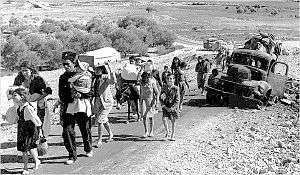Palestinian diaspora
| Part of a series on |
| Palestinians |
|---|
 |
| Demographics |
| Politics |
|
| Religion / religious sites |
| Culture |
| List of Palestinians |
The Palestinian diaspora (Arabic: الشتات الفلسطيني, al-shatat al-filastini), part of the wider Arab diaspora, are Palestinian people living outside the region of Palestine.
History
The first emigration wave of Arab Christians out of Palestine began in the mid-19th century as a response to the oppression of Palestinian Christians in Ottoman Palestine.[1][2][3]

Since the 1948 Arab–Israeli War, Palestinians have experienced several waves of exile and have spread into different host countries around the world.[4] In addition to the more than 700,000 Palestinian refugees of 1948, hundreds of thousands were also displaced in the 1967 Six-Day War. In fact, after 1967, a number of young Palestinian men were encouraged to migrate to South America.[5] Together, these 1948 and 1967 refugees make up the majority of the Palestinian diaspora.[4][6] Besides those displaced by war, others have emigrated overseas for various reasons such as work opportunity, education[7][8] and religious persecution.[6] In the decade following the 1967 war, for example, an average of 21,000 Palestinians per year were forced out of Israeli-controlled areas.[9] The pattern of Palestinian flight continued during the 1970s, 1980s, and 1990s.
Population
In the absence of a comprehensive census including all Palestinian diaspora populations and those that remained within the area once known as the Mandatory Palestine, exact population figures are difficult to determine. According to the Palestinian Central Bureau of Statistics (PCBS), the number of Palestinians worldwide at the end of 2003 was 9.6 million, an increase of 800,000 since 2001.[10]
The issue of the Palestinian right of return has been of central importance to Palestinians and more broadly the Arab world since 1948.[4] It is the dream of many in the Palestinian diaspora, and is present most strongly in Palestinian refugee camps.[11] In the largest such camp in Lebanon, Ain al-Hilweh, neighborhoods are named for the Galilee towns and villages from which the original refugees came, such as Az-Zeeb, Safsaf and Hittin.[11] Even though 97% of the camp's inhabitants have never seen the towns and villages their parents and grandparents left behind, most insist that the right of return is an inalienable right and one that they will never renounce.[11]
Population figures
It is estimated that more than 6 million Palestinians live in a global diaspora.[12]
The countries outside the Palestinian territories with significant Palestinian populations are:
- Jordan 3,240,000
- Israel 1,650,000
- Syria 630,000
- Chile 500,000 (largest Palestinian community outside the Middle East).
- Lebanon 402,582
- Saudi Arabia 280,245
- Egypt 270,245
- United States 255,000 (the largest concentrations in Chicago, Detroit and Los Angeles (History of Palestinians in Los Angeles)-San Diego).
- Honduras 250,000
- Guatemala est. 200,000
- Mexico 120,000
- Qatar 100,000
- Germany 80,000
- Kuwait 80,000
- El Salvador 70,000
- Brazil 59,000
- Iraq 57,000
- Yemen 55,000
- Canada 50,975
- Australia 45,000
- Libya 44,000
- Greece est. 30,000
- United Kingdom 20,000
- Peru 19,000
- Denmark 15,000
- Colombia 12,000
- Pakistan 10,500
- Japan est. 10,000
- Paraguay 10.000
- Netherlands 9,000
- Sweden 7,000
- Algeria 4,030
- Austria 4,010
- Norway 3,825
- The rest of Latin America, India, Russia, Sub-Saharan Africa and East Asia has fairly small Palestinian populations.
The majority of the estimated 100,000 Palestinians in the European Union (EU) are in the United Kingdom, Denmark, France, Germany, Greece, Italy, the Netherlands, Spain and Sweden. Outside the EU is Norway and Switzerland. Germany's capital Berlin has one of the largest Palestinian communities outside of the Middle East with about 30,000-40,000 people of Palestinian origin residing in the city (~1% of the total population) .[13]
In the United States, this includes a Palestinian community of 800-1,000 in Gallup, New Mexico highly involved in the area's Southwest jewelry industry.[14]
See also
- 1948 Palestinian exodus
- 1949–56 Palestinian exodus
- 1967 Palestinian exodus
- Palestinian exodus from Kuwait (Gulf War)
- Arab diaspora
- List of Palestinians
References
- ↑ The Lebanese in the world: a century of emigration, Albert Habib Hourani, Nadim Shehadi, Centre for Lebanese Studies (Great Britain), Centre for Lebanese Studies in association with I.B. Tauris, 1992
- ↑ Between Argentines and Arabs: Argentine orientalism, Arab immigrants, and the writing of identity, Christina Civantos, SUNY Press, 2005, p. 6.
- ↑ Arab and Jewish immigrants in Latin America: images and realities, by Ignacio Klich, Jeff Lesser, 1998, pp. 165, 108.
- 1 2 3 "The Palestinian Diaspora". Le Monde Diplomatique. Retrieved 2007-09-05.
- ↑ John Tofik Karam, "On the Trail and Trial of a Palestinian Diaspora…" http://journals.cambridge.org/action/displayAbstract?fromPage=online&aid=9070730
- 1 2 "Middle East: Palestine from www.persecution.org". www.persecution.org. February 2007. Retrieved 2007-09-08.
- ↑ "Saudi Arabia finances study abroad for Palestinian students". The embassy of Saudi Arabia in Washington, D.C. 2007-04-25. Archived from the original on 2007-10-13. Retrieved 2007-09-08.
- ↑ "Swarthmore Senior Founds Organization for Palestinian Students in U.S.". Swarthmore. March 27, 2006. Archived from the original on 2007-07-19. Retrieved 2007-09-08.
- ↑ Palestine Refugees: 50 Years of Injustice," The Permanent Observer Mission of Palestine to the United Nations," http://www.palestine-un.org/info/frindex.html (28 Nov. 2002)
- ↑ "Statistical Abstract of Palestine No. 5" (PDF). Palestinian Central Bureau of Statistics. October 2005. Retrieved 2007-09-05.
- 1 2 3 "One Day We'll Rise Again - and Return". Al-Ahram Weekly. 28 October – 3 November 1999. Retrieved 2007-09-11.
- ↑ http://www.globalexchange.org/country/palestine/diaspora
- ↑
- ↑ http://www.nytimes.com/2003/07/18/us/gallup-journal-tension-over-who-prospers-in-an-indian-capital.html
External links
- Shaml - The Palestinian Diaspora and Refugee Centre
- The Palestinian Christian Diaspora in Jordan
- The French Le Monde Diplomatique ("The Diplomatic World") has two web sites with more accurate information on the Palestinian diaspora:
- The global Palestinian diaspora in the world (in French), Fébruary 2000;
- The Palestinian Refugee population in the Middle East (in French), Fébruary 2000.